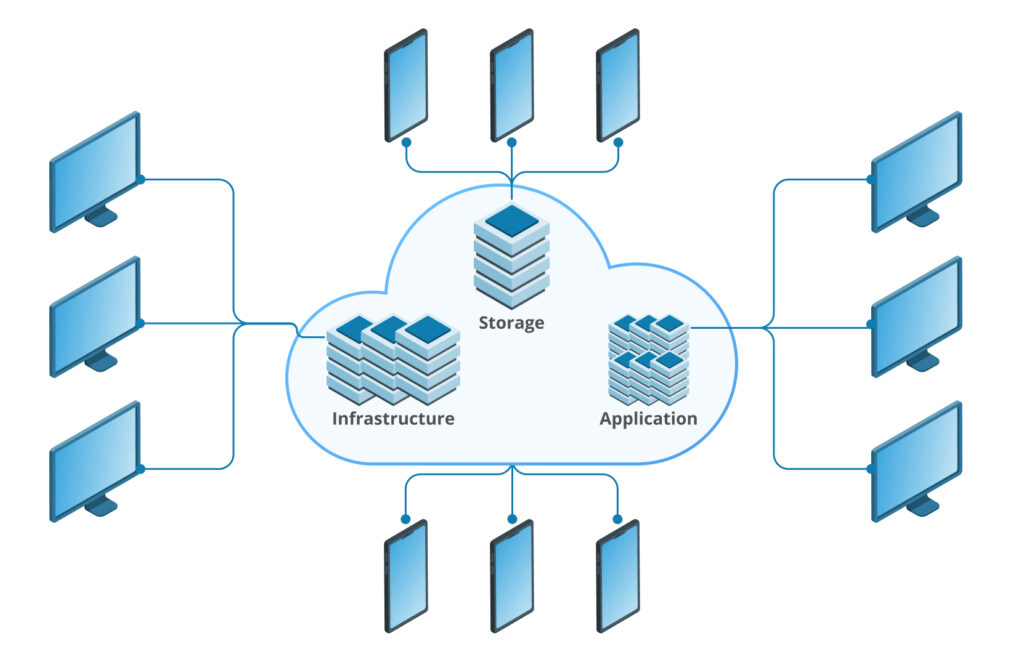Here, you can discover what a cloud provider is and why choosing the right cloud provider is just as important as choosing the right cloud to meet your business requirements.
- Cloud Providers — What Are They?
- Benefits of Using a Cloud Service Provider
- How To Choose a Cloud Service Provider
Cloud Providers — What Are They?
A cloud provider, also known as a cloud service provider, is an IT company that provides customers with virtualised resources based on physical IT infrastructure components, such as servers, storage, networks, etc., on demand, using flexible payment modalities. A cloud provider can own data centres or rent separate computer rooms isolated from others and where it places hardware components.
That is how a cloud provider operates and provides services:

Cloud Service Provider Examples
Here is a list of global companies ranked as the top five players as of early 2024.
Amazon Web Services (AWS). World’s largest cloud provider with over 34% market share, present in 30+ geographical regions, providing 200+ various cloud services.
Microsoft Azure. The main competitor for AWS, which is available in 110+ geographical regions. Corporate users of Microsoft products, including Office 365, are its primary customers.
Google Cloud Platform. Besides standard services available through AWS Azure, it offers customers innovative solutions in Artificial Intelligence, Machine Learning, Data Analytics and Kubernetes.
Alibaba Cloud. Asia’s largest cloud service provider, known for its e-commerce platform. The company owns about 5% of the market.
IBM Cloud. Provider of cloud computing services focusing on multicloud. It offers 170 cloud products and holds about 4% of the market.
Types of Cloud Providers
There is no universally accepted approach to classifying the types of cloud providers, but the top three global players are often referred to as hyperscalers. They combine large networks of data centres and are a perfect match for companies facing ever-increasing volumes of data and computing needs. It is the hyperscalers that, thanks to their IT infrastructures that can quickly scale horizontally, not only meet the demand of such customers, but also enhance availability while reducing storage costs.
Colobridge’s Expert:
“Our company falls into the category of so-called local cloud service providers – they cover a smaller geographical segment of clients, but at the same time, they are often as reliable as hyperscalers and are often better when it comes to quality of service. For example, we have a customised approach to each client when developing and implementing IT infrastructures. We do not offer clients standard cloud service solutions but rather design them taking into account current and expected workloads, business particularities, security requirements and others.
As for the quality of service, we have an advantage here too – for example, you can contact your personal manager via several different channels or get a response from a tech support specialist in plain language within 15 minutes. For customers who want to improve infrastructure fault tolerance or reduce content delivery time in remote regions, we can implement a multicloud model by connecting to hyperscalers. This approach makes it possible to choose the best service provider depending on product-specific use cases.”
Benefits of Using a Cloud Service Provider
When comparing using a cloud service provider to on-premises IT infrastructure, the first option will have several advantages.
- There is no need to design, build and implement local IT infrastructure if it was not initially set up. Moreover, the current one can be made more flexible – you can get the necessary computing resources in the cloud anytime.
- Scaling current IT infrastructure is simplified – non-critical workloads can be migrated to the cloud, and you can get as much computing power as they require, and then switch back to the previous consumption pattern. Cloud infrastructure scalability is almost unlimited.
- The client utilises the cloud provider’s experience in designing, implementing, maintaining, ensuring IT infrastructure fault tolerance, and gets expertise in a business-specific area.
- The service provider guarantees that client services will operate smoothly (including those backed by financial commitments) as per SLA and provides access to industry-leading technologies.
Challenges of Using a Cloud Service Provider
Some companies have not yet decided to migrate their IT services to the cloud, and usually justify this with one of the following reasons.
- Dependence on the provider, its terms and products when working with a single service provider (there may be challenges associated with migrating workloads to other platforms) combined with the challenges of managing IT infrastructure when implementing a multicloud strategy.
- The need to comply with industry or corporate security requirements. If a company stores and processes sensitive data, therefore it is impossible to place it in public clouds. Businesses must also clearly understand who (the customer or the cloud provider), when and to what extent is responsible for data security and integrity.
How To Choose a Cloud Service Provider
To minimise the risks associated with migrating IT workloads to a cloud platform, you need to choose a cloud computing service provider responsibly. What really matters:
- its geographical location and whether its data centres are certified;
- the scope of the service level agreement (SLA);
- the scope of the cloud service provider’s product portfolio;
- the quality of the technical support service (language, response time, working hours, etc.)
We discussed each of these criteria in detail in our article How to Choose a Cloud Service Provider: Evaluation Criteria and Recommendations.
Please contact our managers to learn more about how corporate cloud provider Colobridge can help you implement a productive, fault-tolerant, and flexible IT infrastructure.





